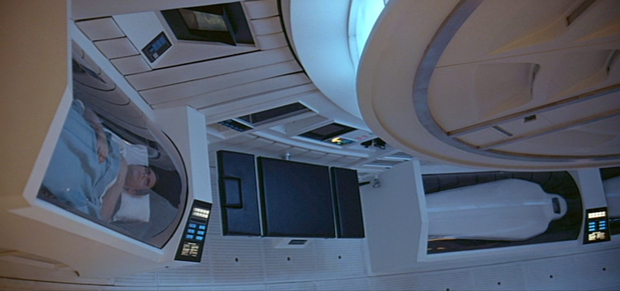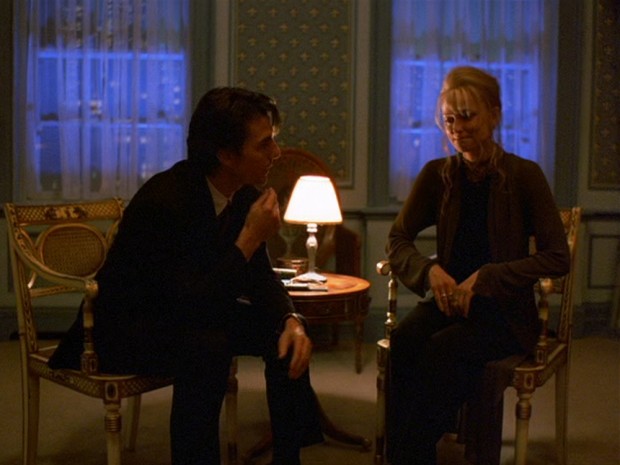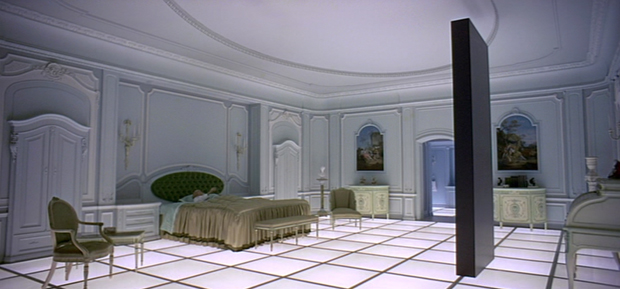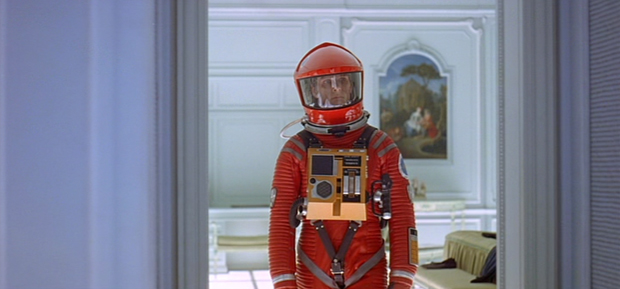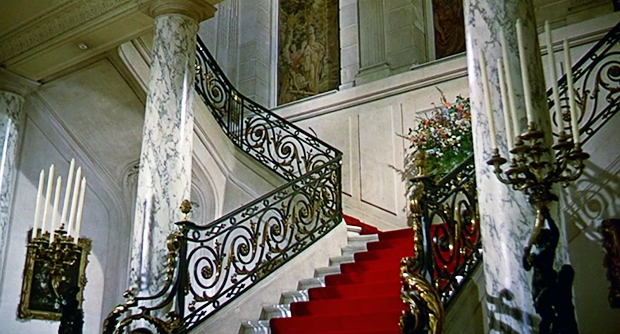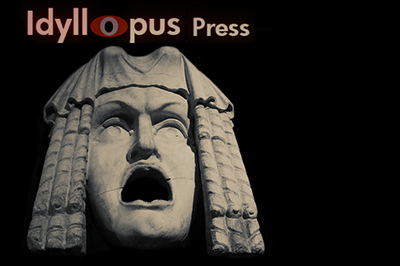
Go to TOC for this film ( (which has also a statement on purpose and manner of analysis and a disclaimer as to caveat emptor and my knowing anything authoritatively, which I do not, but I do try to not know earnestly, with some discretion, and considerable thought).
Though the paintings in the Jupiter and Beyond the Infinite "hotel room" in 2001 remind greatly of the work of the Rococo artist Fragonard, the only one I've been able to identify thus far is either Francois Boucher's "La Tendre Pastorale" or a simulation of it. I include in the leading image to this post the 2 versions of "Tendre Pastorale" I've been able to find online by Boucher. The painting to the left of the bathroom entrance in 2001 is a combination of the two versions but also has a few differences from them both. (After I'd located these, I have since seen that others have as well.) Does this mean there was a third version by Boucher, or did Kubrick instead have a painting done that combined the two versions? I don't know. Studying other paintings by Boucher, I've as yet been unable to make matches to the remaining three paintings in 2001 but they seem to be at least in the style of Boucher, a Rococo artist who was a teacher of Fragonard, was a favorite of Madame de Pompadour, did landscape scenes that decorated the King Louis XV's Versaille living quarters, and was made First Painter of the King in 1765.
With the differences between this painting in the film and the two Bouchers we are then invited to consider the "why" of this amalgamation, and its differences from the originals, in relationship to this seeming fabrication of a hotel room in which Bowman finds himself.
In Clarke's book, 2001, what looks familiar sometimes only bears a resemblance on close examination or becomes something else altogether. At a distance, text is observed on items but up close the print becomes illegible. Food items may have a recognizable container but what is within is alien. The room is inexact, and in some ways much like a dream. Clarke's book, arriving after the film, ultimately compares Bowman's quarters to a movie set. "His hosts had based their ideas of terrestrial living upon TV programs. His feeling that he was inside a movie set was almost entirely true."
The use of this Boucher painting is interesting to me as it seems a number of his pastorales were used as springboards for pantomime theatricals, which fits in with Kubrick's film having no dialogue for long stretches, and none at all in this section.
Also interesting to me, if we can assume that these digital orientations of Boucher's paintings are correct, is that Kubrick chose a work by Boucher in which we have a horizontal flip as a difference between two versions. I have written extensively in my analyses on Kubrick's use of horizontal flips and how these flips appear to work in relationship to the monolith in 2001 and in his other films. The monolith comes to signify a place of the meeting of opposites, a between. In my analysis of Lolita I play with it as a concept similar to the Japanese concept of "Ma", at least for that film.
As Lolita speaks to her mother about Quilty, we see also a book in the background. The name on its title seems to be May but we only see Ma at this point. (The title is actually, Maya: The Riddle and Rediscovery of a Lost Civilization by Charles Gallencamp. Thanks to Madison J for alerting.) I think there would be relevance to the situation as it so stands out. There's MA, big and bold. But there's no reason to reiterate the concept of mother. We already know that Charlotte is the mother. Instead, especially with Quilty referred to several times as having an "Oriental" sensibility, I'm opting to look at the Japanese word Ma, another pointer to this being Charlotte saying, "That's neither here nor there." Which is Ma. It is the place between. Wikipedia, which shows the kanji, gives it as translating roughly in Japanese as a gap, space, pause, or the space between two structural parts. Suggestive of an interval. "...ma can be defined as experiential place understood with emphasis on interval." The violinist, Isaac Stern, related it in music as the spaces between the notes, "silences which give form."
From the 2nd part of my analysis on Lolita
After the landscapes and diorama-like settings in The Dawn of Man section, and not counting the Earth landscapes used in the Star Gate sequence, with the exception of one instance we have no pastoral landscape views of Earth until in this room, and these are painted. That one exception is an easily overlooked landscape that appears when Frank is watching his birthday greeting from his parents.
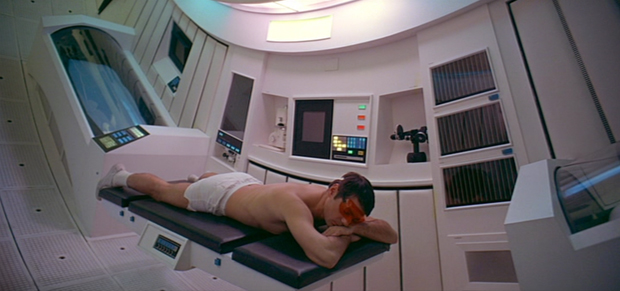
In shot 257 we are shown Frank on his tanning bed. In shot 258 we see Frank's parents seated at a table with Frank's cake, all its candles lit.
Then in shots 259 and 260 we are shown Dave, asleep in bed, while we continue to hear the birthday message from Frank's parents.
After being shown Dave, we return to Frank on his tanning bed.
The viewer may assume, knowing that Dave and Frank sleep in shifts, that Dave is asleep while Frank is listening to his message. However, there is but one tanning bed, which is at the head of Dave's sleeping pod. In shot 257 (and others) we clearly see Dave's pod and that it is empty. In shots 259 and 260, when Dave is asleep in his pod, we clearly see that the tanning bed is empty, Frank isn't on it. Knowing this, one imagines Kubrick is just showing sundry events out of order, which he likely is. But the sequence is still something to take note of, for when we later see Frank asleep, Dave is clearly depicted in the same shot sketching those kept in hibernation. While Dave sleeps, Frank is out of the picture. When Frank sleeps, Dave is present.
In shot 259 we see an earth landscape in the monitor above Dave's bed while he is sleeping. That is the only landscape of earth we will observe between the Dawn of Man section and the paintings in the "hotel" room.
In shot 259, when we see the landscape above Dave's bed, his sleeping posture is relaxed, his hands open. In shot 260, there is no landscape above Dave's bed, and his sleeping posture is more rigid, his face tenser, his hands closed in fists. I am going to assume this difference is for a reason, as in section two we twice observed Heywood sleeping, and the first time a hand was open, a pen floating above it, and the second time a flight attendant was watching a karate program, karate meaning "open hand".
In the "hotel" room we see also porcelains that continue with the theme of the lovers in the paintings, bringing them into 3d. This style of painting, though showing rural figures, was concerned with courtly romance.
We already know, by its appearance, that the room of the dead man in Eyes Wide Shut is intended to recall 2001.
Marion's declaration of love for Bill at the dead man's bedside could be interpreted as also referring back to 2001 and the courtly romance in the Boucher painting, and the porcelains.
Why does Kubrick introduce the subject of romantic love in the "hotel" room? That it is courtly love is known due the Boucher painting, and represented again with Bill and Marion. Courtly love, as conceived of in the Middle Ages, celebrated by troubadours, was characterized as aristocratic, ritualistic, secret, and forbidden, as in adulterous. Politics and business had everything to do with aristocratic marriage as approved by families and the church. Courtly love was devoted to romance and passion between individuals. With courtly love, the man often wooed the woman, but here it is Marion who pursues Bill. She doesn't love the man to whom she is engaged, who Kubrick depicts as an echo of Bill, looking somewhat like him. She is instead in love with Bill, and, in courtly fashion, Marion professes she is willing to spend her days living somewhere within his shadow, never seeing him again, content with his at least once acknowledging her love and giving it justification.
In 2001, the only "love" relationships we've observed thus far are familial, the primate holding a child, Heywood interacting with his daughter, then with a Russian woman with whom they both discuss family, and Frank being wished happy birthday by his parents. Yet, at film's end, Dave Bowman is surrounded by imagery of secret, courtly, romantic love.
A redditor, subline-affinity, posted that the painting observed on the wall opposite the bathroom, screen right, was the same as in Hitchcock's 1956 The Man Who Knew Too Much. This made the rounds on Twitter, which is how I learned of it. The identity of the painter is as yet unidentified, and we don't even get a very good view of the painting in either film, but we may still be able to try to imagine some significance of its use for Kubrick.
In The Man Who Knew Too Much, two individuals who are planning an assassination kidnap the child of a couple they fear may know about their plans. They threaten the child will come to harm if the parents go to the police with their knowledge. The kidnapers eventually take this child to the embassy of the country of which the endangered man is a prime minister, and who survives the assassination attempt. Eventually having reason to believe their child is at this embassy, the parents goes there with the hope of finding their son.
The painting in question is seen, in the film, at this embassy, which was a composite of several locations. The staircase in the area where we see the painting is always reported to have been filmed at what was the Park Lane House.
I'm going to borrow a couple images from Movie Tourist Blogspot, screengrabs from the film, of the staircase and painting.
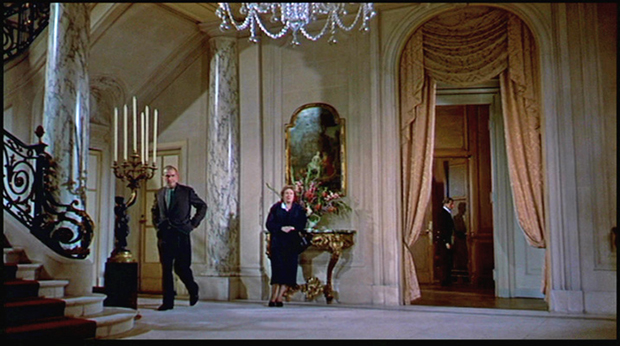

The Park Lane House was formerly the Holdernesse House then the Londonderry House, a "double-fronted" mansion that was occupied by the Marquesses of Londonderry until its destruction. Though this mansion's staircase was said to have been used for the film, I'm not seeing a match in the below circa 1920s photo.
The child's mother, Jo, sings "Que Sera Sera" for the prime minister in the ballroom. She's hoping that when her son hears her he will respond in some way and she'll be able to find him. Ballroom scenes for the embassy were filmed at the Forbes House. Is this perhaps the staircase from the Forbes house? The image is borrowed from the Maserati Enthusiasts' Page.
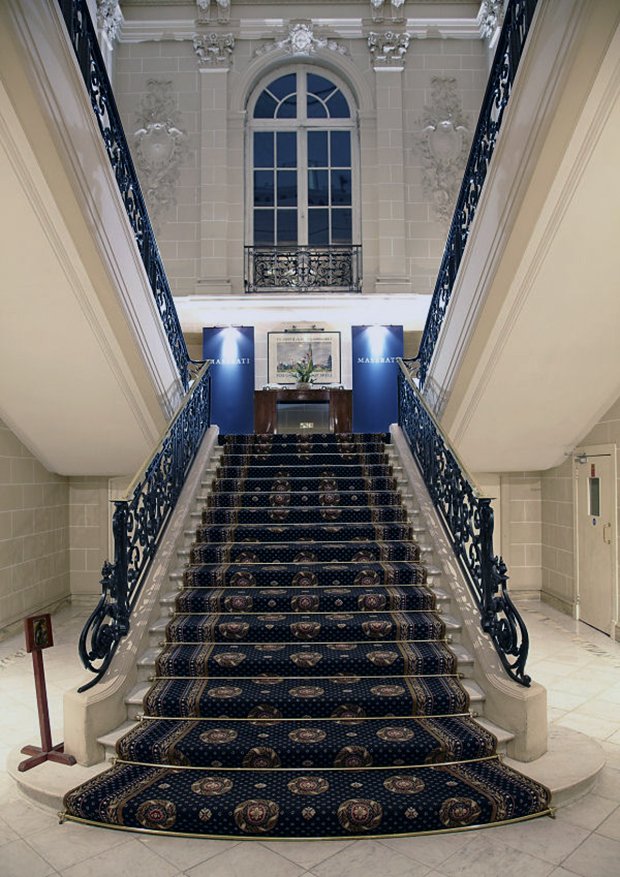
Yes, it's a match, though it doesn't appear to be. The staircase has been completely rebuilt and the structure is different, but there appears to have been an attempt to keep a semblance of the scrollwork of the original wrought iron. How we can tell this is the staircase in the film is with the similarity of the walls surrounding the window that looks over the landing, and the basework of the pilaster is the same.
I have said in my analysis that the "hotel" room in 2001 appears to be a greatly morphed composite of things viewed earlier in the film, and that with it we are also revisiting the interior of the Space Station 5 where the meeting with the Russians was held. The floor in the room is the same as the ceiling at the Space Station. A Hilton reception area was viewed at the Space Station. Never mind that the staircase in The Man Who Knew Too Much is at the Forbes House, for some reason it is written up everywhere that the location for the staircase was the Park Lane/Londonderry House. After it was demolished, the London Hilton rose in its place in 1963. That may be a reason, I believe, why Kubrick has used this painting, from The Man Who Knew Too Much, in the "hotel" room scene, because it supplies a link with the Hilton and thus the Hilton at the Space Station.
What was said at Space Station 5? Heywood had said, "See you on the way back." And his child had asked for a Bushbaby. The audience is now seeing the Space Station on the way back, and the last shot of the film is an infant.
That the subject of love becomes such a focus in the room--its paintings and porcelains--can be perhaps, in part, traced back to HAL's singing, "Daisy, Daisy, give me your answer, do. I'm half crazy, all for the love of you." As the bicycle is built for two (and is a bi-cycle), we have returned again to the theme of doubles. When the monolith appears, we find these doubles as a mirroring symmetry to either side of it, the monolith serving as a "between" into which Bowman passes.
If we return to the painting from The Man Who Knew Too Much, knowing it is from that film, understanding how important is the grand staircase to that film, the kidnaper of the child accidentally shooting himself to death on its stairs, we may look then at the images of the Forbes and Park Lane houses staircases and examine their perfect symmetry and consider if Kubrick had them in mind as subtext. From there we could then return to Lolita, in which Humbert murders Quilty at the height of a grand staircase.
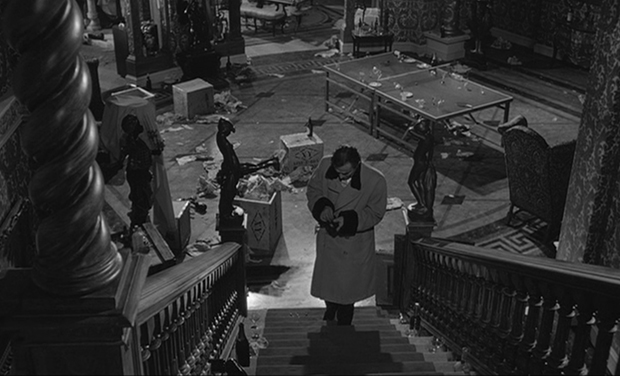
We could then look to The Shining and Wendy's battle with Jack on the grand staircase.
But there is another and even greater significance had to Kubrick's bringing into the "hotel" room of Dave Bowman this painting, by means of The Man Who Knew Too Much, and that is the relationship of Hitchcock's film to Marlowe's Faustus, most overtly found in Jo's singing "Que sera sera", which is from Faustus' self-argument as he prepares to abandon hope for Calvinist predestination.
When all is done, divinity is best;
Jerome’s Bible, Faustus, view it well. [Reads.]
Stipendium peccati mors est. Ha! Stipendium, &c.
“The reward of sin is death.” That’s hard. [Reads.]
Si peccasse negamus fallimur et nulla est in nobis veritas.
“If we say that we have no sin we deceive ourselves, and there’s no truth in us.” Why then, belike we must sin and so consequently die.
Ay, we must die an everlasting death.
What doctrine call you this, Che sera sera,
“What will be shall be?” Divinity, adieu
These metaphysics of magicians
And necromantic books are heavenly;
Lines, circles, scenes, letters, and characters,
Ay, these are those that Faustus most desires.
O what a world of profit and delight,
Of power, of honour, of omnipotence
Is promised to the studious artisan!
All things that move between the quiet poles
Shall be at my command. Emperor and kings
Are but obeyed in their several provinces,
Nor can they raise the wind or rend the clouds;
But his dominion that exceeds in this
Stretcheth as far as doth the mind of man.
A sound magician is a mighty god:
Here, Faustus, try thy brains to gain a deity.
Hitchcock was certainly thinking of Faustus in his 1956 version of The Man Who Knew Too Much. I've already discussed portions of its plot, but now I should give a fuller description, which means I will also be going over previously covered territory. At the film's beginning, we find Benjamin McKenna (Jimmy Stewart) and Jo (Doris Day) and their son, in French Morocco. They are riding on a bus when the boy accidentally pulls aside a woman's veil, revealing her face. This causes a commotion that attracts the attention of another individual on the bus who gets involved and smooths things over as he is able to speak Arabic. He is Louis Bernard and explains to them how a Muslim woman never removes her veil in public. Ben ends up telling Louis all about himself, how he's a doctor at the Good Samaritan Hospital in Indiana, and is going to Marrakech as he was attending a medical convention in Paris and thought he'd revisit North Africa, where he was stationed in WWII. Jo complains to her husband that Louis knows too much about him, and wonders what Louis was up to. Later, at the hotel, she sings "Que sera sera" with her son, Hank, and says to him, of his voice, "Oh, you're divine". Which is certainly a tip that Hitchcock was thinking of Faustus who embraces his "Che sera sera" with musings on divinity. At this point, Louis, who they'd arranged to go to dinner with, arrives. Before leaving for dinner, they are interrupted by a knock on the door. It is a man who says he was looking for someone else. Louis is perturbed and leaves. Later, Ben and Jo witness an Arabic man stabbed in the street, who transmits to Ben secret knowledge as he dies. The man turns out to be Louis in disguise. He tells Ben, "A man, a statesman, he is to be killed, assassinated, in London, soon, very soon. Tell them in London, Ambrose Chappell."
The son knew too much by accidentally withdrawing the woman's veil, which is to stumble upon the sacred. Louis Bernard appears in conjunction with this unveiling and is stated to have known too much about Ben. He is also a kind of Mephistopheles who draws Faustus into trouble. He transmits to Ben his knowledge, and now Ben, who is a doctor, like Faustus, knows too much. Jo, also, comes to know too much.
Ambrose is from Ambrosios, meaning "immortal".
There is much talk about food in the film, and this could be a reason why, due to ambrosia being the food of the gods.
At first, Ben and Jo think Ambrose Chappell is a man, then realize instead it is a place. As it turns out, Ambrose Chappell is a headquarters for the conspirators under the guise of a church. (In the 1934 film, the headquarters is associated with a sun-worshipping cult.) Just before Ben arrives, they are offering Hank milk and biscuits, after which they want him to go to sleep. Down in the chapel, attendees are singing a hymn on the crucifixion. It has to do with Christ's death as atonement for sin, and has the injunction to sin no more. Faustus had determined that as the consequence of sin is death, irredeemably, "What will be shall be", he would instead pursue magic.
From whence these dire Portents around,
That Earth and Heav'n amaze?
Wherefore do Earthquakes cleave the Ground,
Why hides the Sun his Rays?
Not thus did Sinai's trembling Head
With sacred Horror nod,
Beneath the dark Pavilion spread
O legislative God.
Thou, Earth, thy lowest Center shake
With Jesu sympathize!
Thou Sun, as Hell's deep Gloom be black,
'Tis thy Creator dies!
See streeming from th'accursed Tree
His all atoning Blood!
Is this the Infinite? 'Tis he,
My Saviour and my God!
For me these Pangs his Soul assail,
For me the Death is born!
My Sin gave sharpness to the Nail
And pointed every Thorn!
Let Sin no more my Soul inslave!
Break, Lord, the Tyrant's Chain!
O save me, whom thou cam'st to save,
Nor bleed nor die in vain!
Ben confronts the conspirators but they get away and take Hank to the embassy. In the meanwhile, Jo has learned a Prime Minister is to be killed at a concert at Albert Hall and goes there. She screams just as the assassin pulls his gun to shoot, coincident with the crash of a cymbal, and prevents the murder. The Prime Minister instead receives only a minor flesh wound. After this, believing that Hank is at the embassy, she goes there and sings "Que sera sera" for the Prime Minister. When she sang earlier, with her son, the mood was playful. At the embassy, Jo is terrified, and the desperation in this rendition is apparent enough that individuals look at each other questioningly. This isn't the comforting, light-hearted performance they had expected. The song is one of distress.
Via the painting that was at the embassy in Hitchcock's film, Faustus is imported into 2001. The word cymbal derives from the green kymbe, meaning a drinking cup, and I have wondered if, with the crash of the glass goblet to the floor, as Dave dines, we are to be reminded of the cymbal crash in The Man Who Knew Too Much, for it is then that Dave now realizes there is someone in the bed, which is him many years hence, ancient and at the point of death.
Whereas Marlowe's Faustus ends in the loss of his soul to eternal damnation, Goethe's Faust is saved by divine love, notably represented by women, which may answer why we also, at the end of Kubrick's film, have a room adorned with paintings and porcelains concerned with love. With Hitchcock, Jo, the mother, is the one who saves her child, and then there is the sympathy, too, of a female kidnaper who encourages the boy to respond to his mother's song rather than silencing him. We have an optimistic ending. Kubrick is also optimistic, in as much as we know that Dave Bowman is reborn and seems to have achieved enlightenment. The love he alludes to in the paintings and porcelains is expressed in romantic, courtly terms, which rather than having to do with the purely sensual, often now interpreted as frivolous and fleeting, will instead represent "true" love, and I would think ultimately has to do with the Shekinah, the divine feminine, which is the same as the merciful godess of Goethe's Faust. It is the love ordained by spirit. If both the female and male principles are necessary for birth, then they must be present in Bowman's hotel room so that he may be reborn.
I have already written, in part one of my analysis of The Shining, how Faust is referenced there. As we find elements of this bedroom scene in the room of the dead man in Eyes Wide Shut, in the final analysis of that film we should consider also its undeniable relationship to Faust with Bill as the man who knew too much. But as for optimistic versions, in which Faust finds salvation, despite the hope of love, they do not answer the Calvinist assertion of predestination that leaves Marlowe's Faust without any real force of will, wherein is the ultimate tragedy in Marlowe's Faustus. Kubrick addressing the problem of free will versus predestination in nearly all of his films differs in that one could argue that both free will and predestination have equal force in his work, his stories not making a choice ultimately between one or the other, free will and predestination intertwined and existing simultaneously.
April 2018. Approx 3900 words or 8 single-spaced pages. A 30 minute read at 130 wpm.
Return to the top of the page.
Return to Table of Contents for "2001: A Space Odyssey" analysis
Link to the main film page for all the analyses

